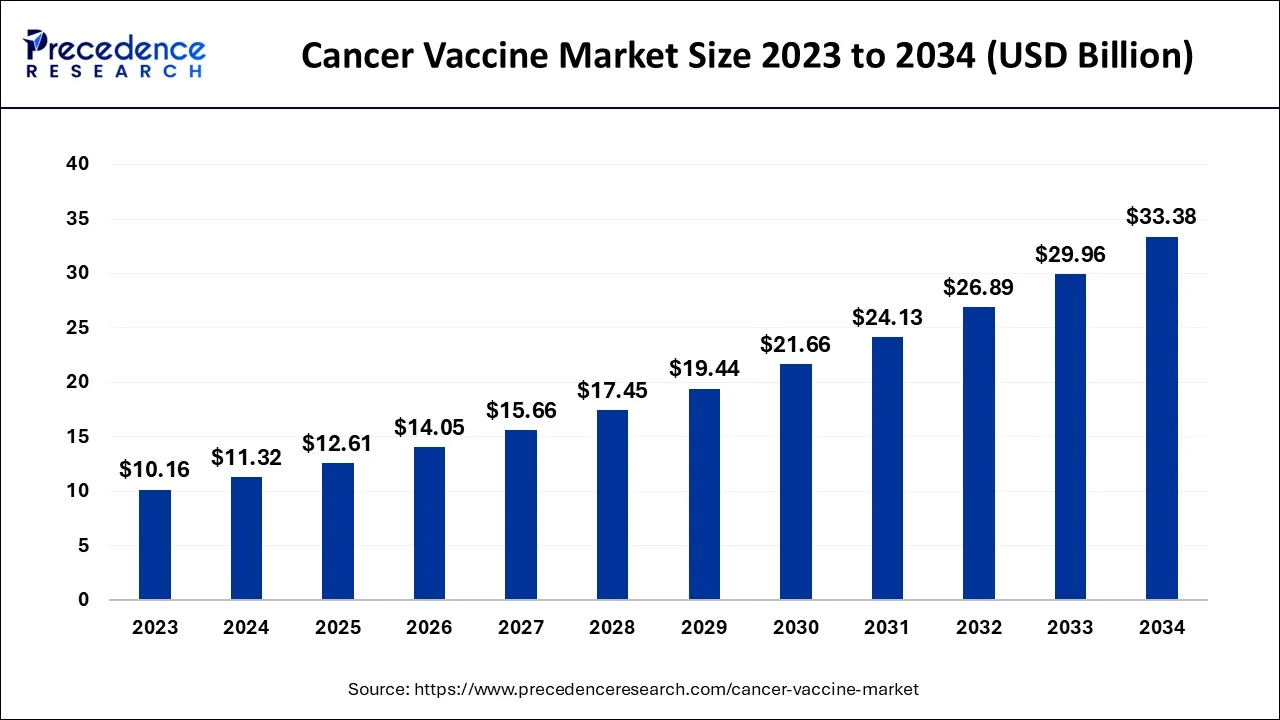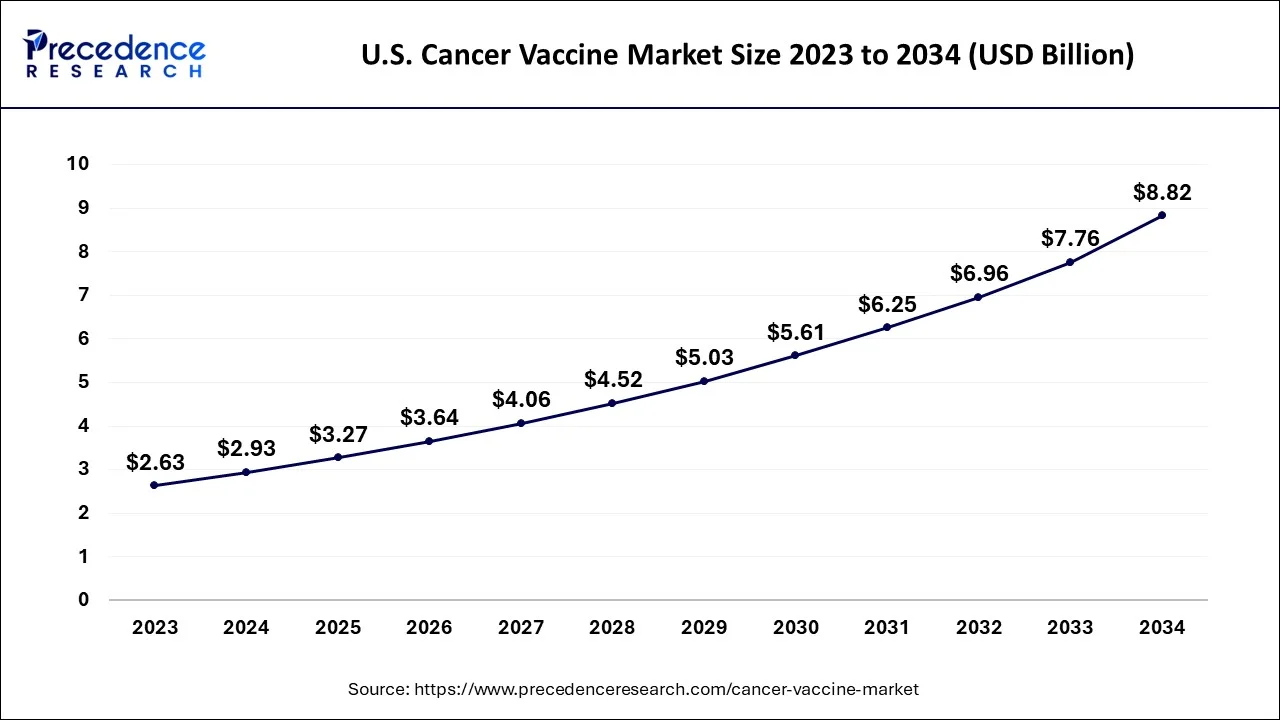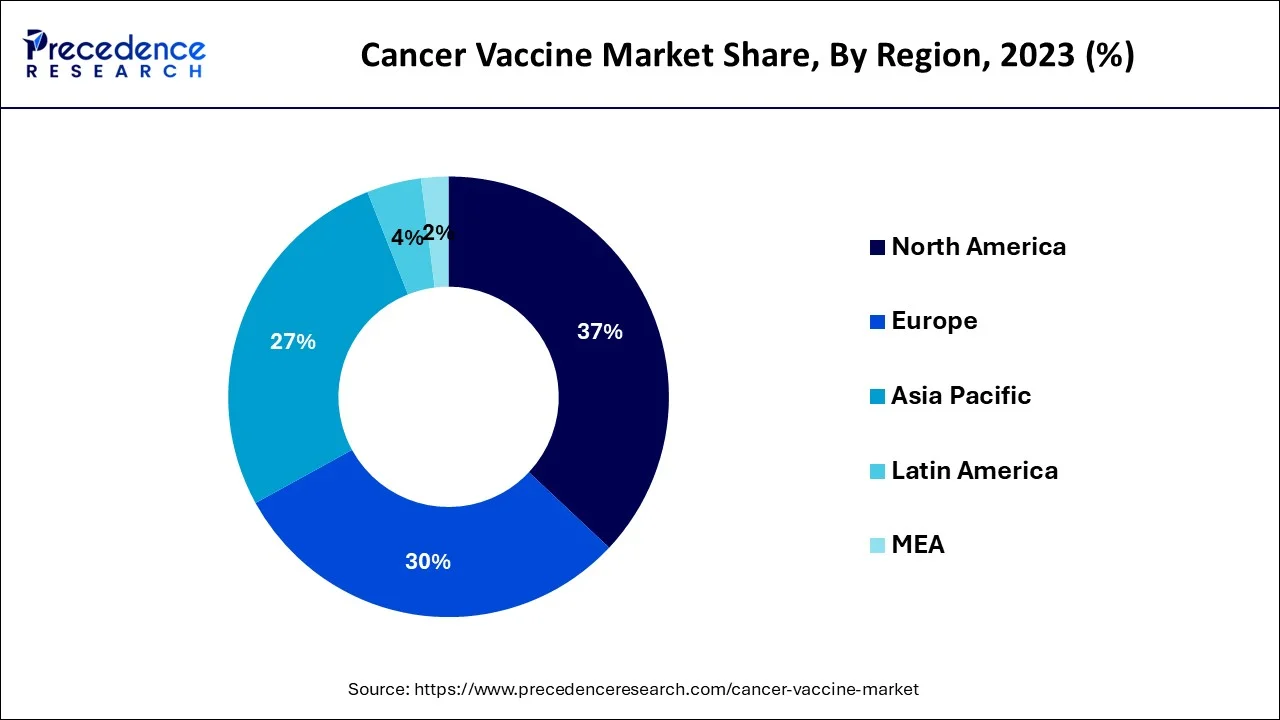January 2025
The global cancer vaccine market size accounted for USD 12.61 billion in 2025 and is projected to surpass around USD 33.38 billion by 2034, representing a healthy CAGR of 11.42% between 2025 and 2034. The North America cancer vaccine market size was calculated at USD 4.19 billion in 2024 and is expected to grow at a fastest CAGR of 11.41% during the forecast year. The market sizing and forecasts are revenue-based (USD Million/Billion), with 2024 as the base year.
The global cancer vaccine market size was estimated at USD 11.32 billion in 2024 and is anticipated to reach around USD 33.38 billion by 2034, expanding at a CAGR of 11.42% between 2025 and 2034.

The U.S. cancer vaccine market size accounted for USD 2.93 billion in 2024 and is predicted to be worth around USD 8.82 billion by 2034, growing at a CAGR of 11.65% between 2025 and 2034.

North America dominated the market with the largest market size in 2024, the region is expected to sustain its dominance throughout the forecast period. The region’s dominance is attributed to the well-established healthcare system in North America that promotes vaccination for cancer. Moreover, the rising incidence of cancer in the region fuels the demand for cancer vaccines. The potential of researchers and developers to invest in the innovation of cancer vaccines also highlights the growth of the market.
North America’s robust regulatory framework, particularly the rigorous approval process by the U.S. Food and Drug Administration, ensures that cancer vaccines meet stringent safety and efficacy standards. This fosters confidence among both patients and healthcare professionals in the effectiveness of these vaccines.

Asia Pacific is expected to witness the fastest rate of growth during the forecast period. The vast population of the region along with rising cases of cancer across the region promote the growth of the market. With the growing aging population and lifestyle factors, the rising investments in research and development activities also promote the growth of the market in Asia Pacific. Moreover, the region’s improving healthcare infrastructure is expected to make these vaccines even more accessible for the patient base. Collaborations between academic institutions and research centers along with pharmaceutical companies in Asia Pacific also fuel the market’s growth.
Cancer is considered one of the most complex diseases across the globe, which is also becoming a significant cause of mortality. The global cancer vaccine market revolves around the research, development, production and distribution of vaccine-based treatment for treating cancer. Cancer vaccines are responsible for the prevention of cancer, these vaccines also promote the power of fighting against the carcinogen's cells. Rising cases of cancer across the globe has forced the healthcare sector to adopt cancer vaccines rapidly.
There are currently two approved cancer vaccines available in the market Human Papillomavirus (HPV) Vaccine and Hepatitis B Vaccine. The Papillomavirus (HPV) Vaccine is greatly effective in the prevention of the HPV virus. There are several types of HPV infections that can cause various types of cancer like head and neck cancers, cervical cancer, anal cancer, vaginal cancer, vulvar cancer, and penile cancer. The Papillomavirus (HPV) Vaccine greatly reduces the risk of cancer. Additionally, Hepatitis B Vaccines are available for the prevention of liver diseases caused by the hepatitis B virus.
The cancer vaccine market is accelerating towards its peak, encouraged by mRNA technology and artificial intelligence. In 2024, Moderna and Merck's personalized mRNA vaccine, mRNA-4157/V940, led to a dramatic 44% decrease in melanoma recurrence when used with Keytruda. Similarly, a study from Yale University demonstrated that a personalized vaccine reversed advanced kidney cancer in nine patients, and all remained disease-free for three years. Likewise, the role of AI is supporting this shift; Oracle's Larry Ellison proposed that AI could lower mRNA cancer vaccine production time to 48 hours. This breakthrough, in combination with a number of strategic partnerships like GSK's £ 50 million partnership with Oxford University, is moving the industry ahead toward an expected valuation of USD 21.39 billion by 2032.
Cancer vaccine is observed to be a potential treatment for fighting against antigens and destroying them. The rising aging population and increasing awareness for the treatment and prevention of cancer fuel the growth of the market. As the emphasis on rapid diagnosis of cancer grows, the market is expected to be accelerated in the upcoming years. Multiple governments and administrative bodies are actively involved in initiatives that promote the treatment and diagnostic methods, especially for cervical and breast cancer types. This element is expected to continue to act as a growth factor for the market.
| Report Coverage | Details |
| Market Size by 2034 | USD 33.38 Billion |
| Market Size in 2025 | USD 12.61 Billion |
| Market Size in 2024 | USD 11.32 Billion |
| Growth Rate from 2025 to 2034 | CAGR of 11.42% |
| Largest Market | North America |
| Fastest Growing Market | Asia Pacific |
| Base Year | 2024 |
| Forecast Period | 2025 To 2034 |
| Segments Covered | Type, Indication, Distribution Channel, and Region |
| Regions Covered | North America, Europe, Asia-Pacific, Latin America, and Middle East & Africa |
Rising threats of cervical cancer
According to the estimation of cancer.net, in 2024, approximately 13,960 women in the United States will be diagnosed with cervical cancer (invasive). Such rising threats of cervical cancer among female patients is expected to act as a driver for the global cancer vaccine market. Despite increased awareness, cervical cancer incidence remains high in few regions. This continues the demand for vaccines, especially in areas with limited access to regular screening and healthcare services.
With such threats, the utilization of HPV vaccine is observed to grow. The growing concern around cervical cancer is attracting investments and research efforts leading to the development of more advanced vaccines and treatments, thus driving the market’s growth.
Higher cost of vaccination
Generally, cancer vaccines are costly owing to the vast research efforts and investments done for the development of the same. The high cost of cancer vaccine may limit patients in economically weaker areas or even in underdeveloped areas. The cost can also limit healthcare professionals from offering vaccination services at their centers. Thus, the cost factor associated with the cancer vaccine mostly acts as a restraint for the market’s expansion.
Emergence of immunotherapeutic vaccines
There have been clinical trials for therapeutic cancer vaccinations. The evaluation of therapeutic cancer vaccines is done in several categories. These could be molecular, viral, or biological (whole tumor/immune cells) vectors. By adopting the ideal vaccine delivery formulation, co-administering immunological adjuvants, immune stimulatory cytokines, and incorporating costimulatory molecules, the therapeutic effectiveness of these drugs has been increased. Numerous novel immunotherapy approaches have been developed as a result of recent improvements in vaccine formulations that successfully activate effector T cells, improve antigen presentation, and prevent tumor-induced immunosuppressive pathways. Thus, the emergence of immunotherapeutic vaccines in the industry is observed to present multiple opportunities for the market.
The preventive segment held the largest share of the market in 2024, the segment is expected to grow at a significant rate throughout the forecast period. Preventive vaccines are gaining popularity due to the increasing awareness of the prevention of cancer. The HPV vaccine is one of the best examples of preventive vaccines for the prevention of anus, vagina, throat, and penis cancer. Preventive vaccines are injected before the occurrence of the cancer the body. As the education about cancer rises, the demand for preventive vaccination for cancer rises.
The therapeutics segment is expected to witness significant growth in the market during the forecast period. Therapeutic vaccines are made from the cancer cells' protein from the surface of the cancer cells. Therapeutic vaccines are used to stimulate the immune system to attract cancer cells. Therapeutic vaccines are personalized vaccines tailored for individual patients. However, the concerns associated with therapeutics-based vaccination slow down the growth of the segment.
The cervical cancer segment dominated the market with the highest market share in 2024. Cervical cancer is generally referred to as one of the common cancer types in women. Cervical cancer occurs in the cervix cell, the lower part of the uterus which connects the vagina. A sexually transmitted infection human papillomavirus (HPV) plays an important role in the cause of most cervical cancer.
Governments are actively participating in promotional activities to boost awareness about cervical cancer and its treatment/therapeutics. This factor is expected to highlight the segment’s expansion for upcoming years.
The hospital segment dominated the market in 2024. The segment will continue its dominance due to the rising cases of patients visiting the hospitals for the detection and diagnosis of cancer. A significant rise in the supply mechanism of medication and therapeutics for cancer in hospitals with large patient base also promote the segment’s growth. For multiple treatments, hospitals are considered to be the most potential channel owing to their well-equipped infrastructure. Moreover, the presence of skilled professionals at hospitals promotes the growth of the segment.
Hospitals adhere to stringent safety and sanitation protocols, minimizing the risk of contamination during vaccine administration. Hospitals are typically well-connected and offer a range of medical services, making it convenient for patients.
By Type
By Indication
By Technology
By Distribution Channel
By Region
For inquiries regarding discounts, bulk purchases, or customization requests, please contact us at sales@precedenceresearch.com
No cookie-cutter, only authentic analysis – take the 1st step to become a Precedence Research client
January 2025
June 2025
September 2024
October 2024